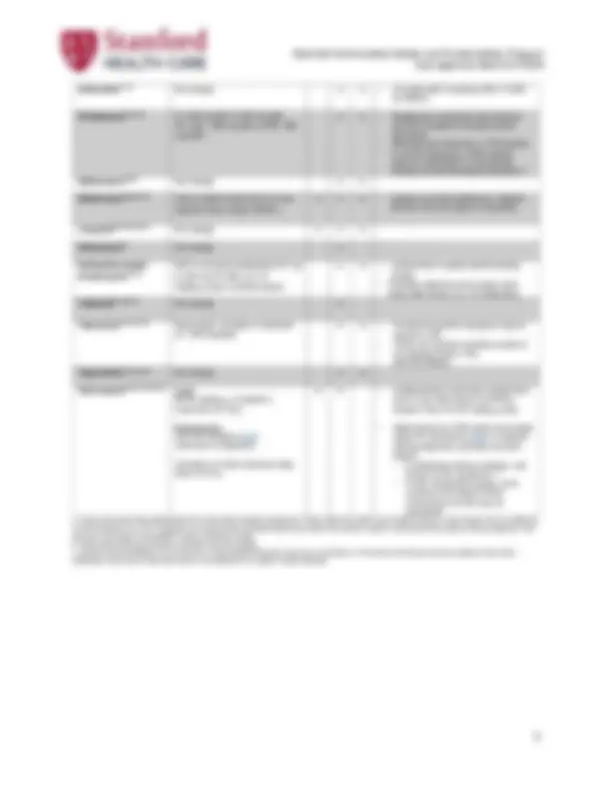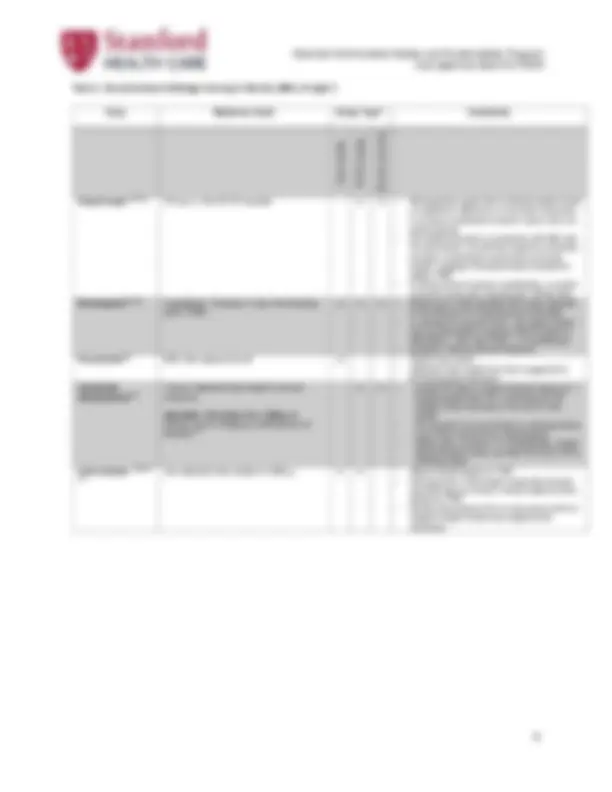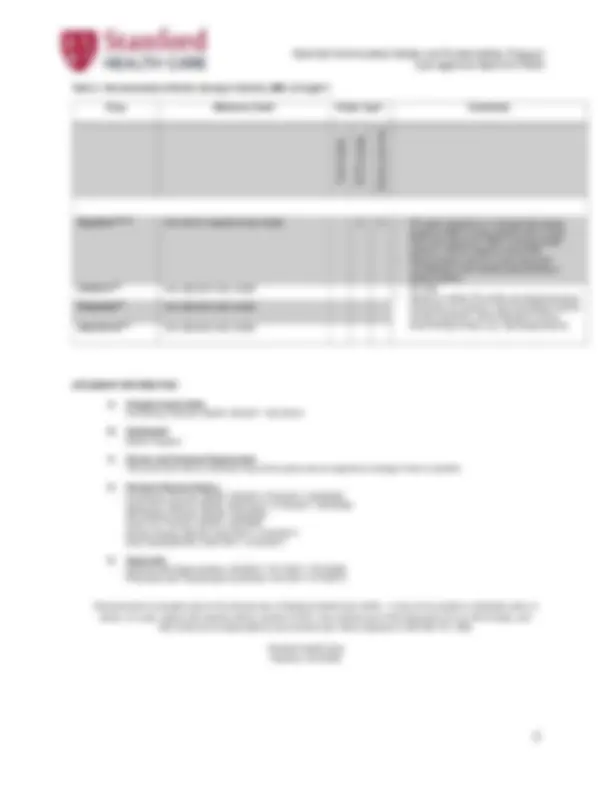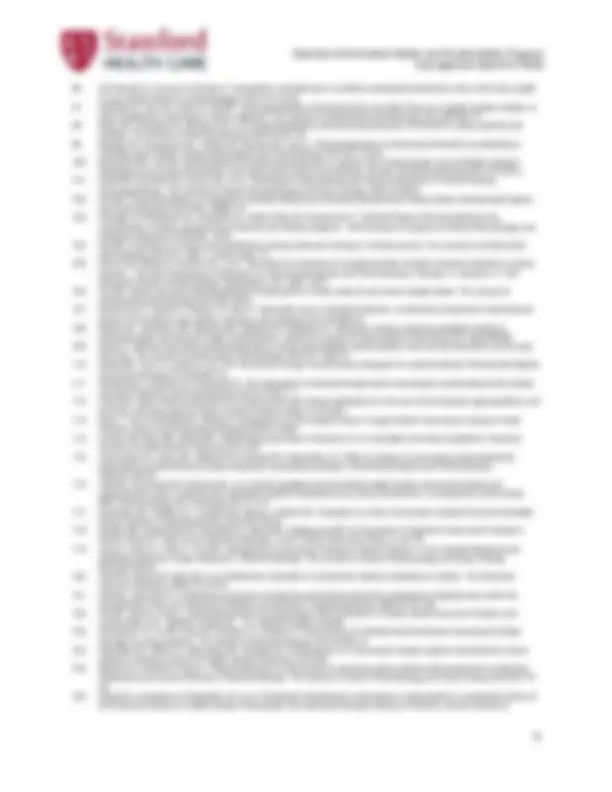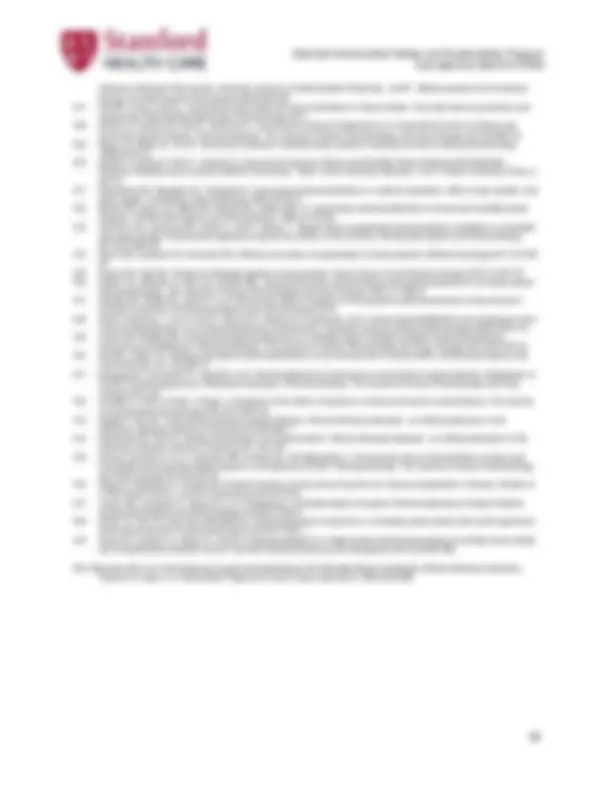Download SHC Antimicrobial Dosing Guide for Obesity and more Lecture notes Pharmacology in PDF only on Docsity!
Last approval date 5/27/
SHC Antimicrobial Dosing Guide for Obesity
Definitions and Equations
BMI = weight (kg) height 2 (m 2 )
Body Weight Equation^1
IBW (kg) Ideal body weight
Male: 50. 0 + 2. 3 × (𝑛𝑛𝑛𝑛𝑛𝑛𝑛𝑛𝑛𝑛𝑛𝑛 𝑜𝑜𝑜𝑜 𝑖𝑖𝑛𝑛𝑖𝑖ℎ𝑛𝑛𝑒𝑒 𝑜𝑜𝑜𝑜𝑛𝑛𝑛𝑛 5 𝑜𝑜𝑓𝑓) Female: 45. 5 + 2. 3 × (𝑛𝑛𝑛𝑛𝑛𝑛𝑛𝑛𝑛𝑛𝑛𝑛 𝑜𝑜𝑜𝑜 𝑖𝑖𝑛𝑛𝑖𝑖ℎ𝑛𝑛𝑒𝑒 𝑜𝑜𝑜𝑜𝑛𝑛𝑛𝑛 5 𝑜𝑜𝑓𝑓) ABW (kg) Adjusted body weight
IBW + C × (TBW – IBW)
C = either 0.3 or 0.4 (ABW0.3 or ABW0.4) LBW 2005 (kg) Lean body weight
Male:
9270 × TBW
6680 + 216 × BMI
Female:
9270 × TBW
8780 + 244 × BMI
LBW (for anti- tuberculosis medications):
- Obesity: ATS/CDC Guidelines recommend dosing based on estimated lean body weight.
- Lean Body Weight (men) = (1.10 x Weight(kg)) - 128 x (Weight 2 /(100 x Height(m))^2 )
- Lean Body Weight (women) = (1.07 x Weight(kg)) - 148 x (Weight 2 /(100 x Height(m))^2 ) TBW (kg) Total/actual body weight
Table 1. 1 Recommended Antibiotic Dosing in Obesity (BMI ≥ 30 kg/m^2 )
Drug Maximum Dosea^ Study Typeb^ Comments
Case studies PK/PD studies Clinical outcomes β-lactams
Amoxicillin No Data - Consider upper limit of normal dosing in severe infections, c^ e.g. up to 1g PO TID Ampicillin Insufficient data ● - Consider upper limit of normal dosing in severe infections, c^ e.g. up to 2g q4h
- Single study with 6 patients: higher V (^) d but decreased Vd/kgTBW , CL unchanged^2 Nafcillin Insufficient data ● (^) - Single case report in critically ill, obese patient 3 : consider upper end of normal dosing in severe infections, c^ e.g. up to 2 g q4h Piperacillin- tazobactam 4-
Up to 4.5 g q8h (prolonged infused over 4 hours) or 4.5 g q6h (30 min infusion)
● ● ● - Prolonged infusion preferred for critically ill, FN, CF, obese with CrCl > 100
- infections with less susceptible pathogens (i.e. MIC ≥16) Cefazolin^15 -^21 Insufficient data ● ● - Consider upper limit of normal dosing in severe infections, e.g. up to 2 g q8h (option for continuous infusion)^22 , or 1.5-2 g q6h intermittent dosing
- In post-trauma critically ill patients, data suggests 2g q6h if CrCl > 215 ml/min. 23
WHO BMI Classification Definition Obese Class I and II (obese) BMI 30-40 kg/m 2 Obese Class III (morbidly obese) BMI ≥ 40 kg/m^2
Last approval date 5/27/
Cephalexin No data - Consider upper end of normal dosing in severe infections, c^ e.g. 500-1000 mg q6h Cefepime,
ceftazidime14,24,
Up to 2g q8h prolonged infusion ● Prolonged infusion if critically ill, CF, FN, obese with CrCl > 100 ml/min, infections with less susceptible pathogens (i.e. MIC ≥8) Ceftazidime/ avibactam26,
No change ●
Ceftolozane/ tazobactam 28
No change ●
Doripenem 14,29-31^ No change ● - Consider extended infusion if targeting a higher PD endpoint of 100% fT>MIC or with less susceptible pathogens (i.e. MIC ≥ 2) Ertapenem13,18,32-^35 No change ● ●
Imipenem No data - Use caution in renal impairment and with high doses (1g q6h): increased risk of seizures Meropenem4,9,18,30,36-^42 Same dose: consider prolonged infusion for critically ill patients
● ● - Prolonged infusion if critically ill, FN, CF, obese with CrCl > 100 ml/min, if targeting a higher PD endpoint of 100% fT>MIC, or infections with less susceptible pathogens (i.e. MIC ≥ 2)
Monobactam
Aztreonam Insufficient data ● - Single case report suggests higher dosing needed^43
- Consider upper end of normal dosing in severe infections, c^ e.g. 2g q6-8h Fluoroquinolones
Ciprofloxacin^44 -^47 In critically ill, septic patients on CRRT with organisms with MICs > 0.5mg/L (e.g. P.aeruginosa, A.baumannii ): > 90kg: 400 mg IV q8h
● ● - Insufficient data except as noted in critically ill, septic patients on CRRT.
- Consider upper end of normal dosing in severe infections, c^ e.g. up to 400 mg IV q8h or 750mg PO BID
Levofloxacin^48 -^51 750 mg q24h ● ● - PK reportedly unaltered by obesity, however, serum levels may be sensitive to CrCl: 1,000 mg q24h has been suggested for CrClIBW > 110 ml/min to target gram negative pathogens Moxifloxacin^52 -^54 No change ●
Aminoglycosides
Amikacin^55 -^57 Use adjusted body weight (ABW0.4)
for initial dose
● - Adjust by TDM
Gentamicin^55 -^61 Use adjusted body weight (ABW0.4)
for initial dose
● - Adjust by TDM
Tobramycin^55 - 57,61,62^ Use adjusted body weight (ABW0.4) for initial dose
● - Adjust by TDM
Polymyxins
Colistin methanesulfonate63-
Use IBW ● - Maximum dose of 360 mg daily to limit the risk of nephrotoxicity
Polymyxin B^67 -^70 Limited data. Consider adjusted
body weight (ABW0.4), especially in upper end of dosing range
● - Consider maximum dose 200 mg or 2 million units daily to limit risk of toxicity
Anti-MRSA agents
Last approval date 5/27/
Table 2. Recommended Antifungal Dosing in Obesity (BMI ≥ 30 kg/m^2 )
Drug Maximum Dosea^ Study Typeb^ Comments
Case studies PK/PD studies Clinical outcomes Caspofungin 133 -^135 70 mg x1, then 50-70 mg daily ● ● - Retrospective study from 9 clinical studies found no significant difference in favorable responses in invasive candidiasis between obese and non- obese groups
- PK studies showed no correlation with BMI and PK parameters, but did find negative correlation between caspofungin peak levels and body weight, suggests increased doses needed for higher TBW
- In clinical trial of invasive candidemia, no safety concerns found with caspofungin 150mg daily Fluconazole^135 -^139 Candidiasis: 12mg/kg x1 load, then 6mg/kg q24h (TBW)
● ● ● - Doses up to 1200 mg daily have been reported in the literature for Cryptococcus meningitis
- In critically ill, esp with CrCl > 50, higher doses may be warranted to achieve PK/PD target of fAUC/MIC > 100, esp if MIC > 2 Candida spp
- Consider TDM for severe infections Flucytosine^135 IBW, then adjust by level ● - Single case report.
- Adjusted body weight has been suggested in life-threatening infections Liposomal Amphotericin 135
Total or adjusted body weight in severe infections
Alternative: fixed dose for ≥ 100kg, i.e. 300mg max for 3mg/kg or 500mg max for 5mg/kg. 150
● ● (^) - Limited PK data in obese humans based on 1- 2mg/kg single dose PK; in general pop PK studies, linear increase in Vd and CL with weight
- PK reported to be non-linear at >5mg/kg doses (max Cmax and AUC at 10mg/kg/day)
- Safety data: at doses 7.5-15mg/kg/day, similar discontinuation rates, but high rate (up to 40%) of kidney injury Voriconazole, 135,140- 145
Use adjusted body weight or LBW 2005 ● ● - Adjust dosing based on TDM
- Retrospective TDM studies frequently showed supratherapeutic levels in obese subjects when dosed by TBW
- Steady state plasma PK of voriconazole did not suggest weight-based dose adjustments necessary
Last approval date 5/27/
Table 3. Recommended Antiviral Dosing in Obesity (BMI ≥ 30 kg/m^2 )
Drug Maximum Dosea^ Study Typeb^ Comments
Case studies PK/PD studies Clinical outcomes
Acyclovir^146 -^148 Use ideal or adjusted body weight ● ● (^) - PK study: 5mg/kg IV x1 showed that dosing based on IBW in obese patients led to lower AUC than dosing by TBW in normal-weight patients. Authors suggest using ABW
- Renal function may be a more important consideration than weight-based dosing in obese patients Cidofovir^149 Use adjusted body weight - No data
- Based on similar PK profile and physiochemical properties as acyclovir, long intracellular half-life (except foscarnet, which deposits in bone), dose-limiting toxicity (e.g. myelosuppression)
Foscarnet^149 Use adjusted body weight
Ganciclovir^149 Use adjusted body weight
DOCUMENT INFORMATION
A. Original Author/Date Lina Meng, PharmD, BCIDP, BCCCP: 12/27/
B. Gatekeeper SASS Program
C. Review and Renewal Requirement This document will be reviewed every three years and as required by change of law or practice
D. Revision/Review History Lina Meng, PharmD, BCIDP, BCCCP: 07/24/2017, 5/22/ Emily Mui, PharmD, BCIDP: 03/27/2017, 07/24/2017, 5/22/ Will Alegria PharmD, BCIDP: 5/22/ David Ha, PharmD, BCIDP: 5/22/ Marisa Holubar MD MS: 03/27/2017, 07/24/ Stan Deresinski MD: 03/27/2017, 07/24/
E. Approvals Antimicrobial Subcommittee: 3/30/2017, 8/17/2017, 5/27/ Pharmacy and Therapeutics Committee: 4/21/2017, 9/15/
This document is intended only for the internal use of Stanford Health Care (SHC). It may not be copied or otherwise used, in whole, or in part, without the express written consent of SHC. Any external use of this document is on an AS IS basis, and SHC shall not be responsible for any external use. Direct inquiries to ASP 650-721-
Stanford Health Care Stanford, CA 94305
Last approval date 5/27/
- de Werra C, Di Micco R, Pilone V, et al. Serum in vivo and in vitro activity of single dose of ertapenem in surgical obese patients for prevention of SSIs. Obesity Surgery 2013;23:911-9.
- Itani KMF, Jensen EH, Finn TS, Tomassini JE, Abramson MA. Effect of body mass index and ertapenem versus cefotetan prophylaxis on surgical site infection in elective colorectal surgery. Surgical infections 2008;9:131-7.
- Wittau M, Paschke S, Kurlbaum M, et al. Population Pharmacokinetics and Target Attainment of Ertapenem in Plasma and Tissue Assessed via Microdialysis in Morbidly Obese Patients after Laparoscopic Visceral Surgery. Antimicrobial Agents and Chemotherapy 2016;61:10.1128/AAC.00952-16. Print 2017 Jan.
- Alobaid AS, Wallis SC, Jarrett P, et al. Effect of Obesity on the Population Pharmacokinetics of Meropenem in Critically Ill Patients. Antimicrobial Agents and Chemotherapy 2016;60:4577-84.
- Srinivas NR. Influence of Morbidly Obesity on the Clinical Pharmacokinetics of Various Anti-Infective Drugs: Reappraisal Using Recent Case Studies-Issues, Dosing Implications, and Considerations. American Journal of Therapeutics 2016.
- Pai MP, Cojutti P, Pea F. Pharmacokinetics and pharmacodynamics of continuous infusion meropenem in overweight, obese, and morbidly obese patients with stable and unstable kidney function: a step toward dose optimization for the treatment of severe Gram-negative bacterial infections. Clinical pharmacokinetics 2015;54:933-41.
- Kitzes-Cohen R, Farin D, Piva G, De Myttenaere-Bursztein SA. Pharmacokinetics and pharmacodynamics of meropenem in critically ill patients. International journal of antimicrobial agents 2002;19:105-10.
- Chung EK, Cheatham SC, Fleming MR, Healy DP, Kays MB. Population pharmacokinetics and pharmacodynamics of meropenem in nonobese, obese, and morbidly obese patients. The Journal of Clinical Pharmacology 2017;57:356-68.
- Wittau M, Scheele J, Kurlbaum M, et al. Population Pharmacokinetics and Target Attainment of Meropenem in Plasma and Tissue of Morbidly Obese Patients after Laparoscopic Intraperitoneal Surgery. Antimicrobial Agents and Chemotherapy 2015;59:6241-7.
- Cheatham SC, Fleming MR, Healy DP, et al. Steady‐state pharmacokinetics and pharmacodynamics of meropenem in morbidly obese patients hospitalized in an intensive care unit. The Journal of Clinical Pharmacology 2014;54:324-30.
- Boccazzi A, Langer M, Mandelli M, Ranzi AM, Urso R. The pharmacokinetics of aztreonam and penetration into the bronchial secretions of critically ill patients. The Journal of antimicrobial chemotherapy 1989;23:401-7.
- Roger C, Wallis SC, Louart B, et al. Comparison of equal doses of continuous venovenous haemofiltration and haemodiafiltration on ciprofloxacin population pharmacokinetics in critically ill patients. Journal of Antimicrobial Chemotherapy 2016;71:1643-50.
- Utrup TR, Mueller EW, Healy DP, Callcut RA, Peterson JD, Hurford WE. High-dose ciprofloxacin for serious gram-negative infection in an obese, critically ill patient receiving continuous venovenous hemodiafiltration. The Annals of Pharmacotherapy 2010;44:1660-4.
- Allard S, Kinzig M, Boivin G, Sörgel F, Lebel M. Intravenous ciprofloxacin disposition in obesity. Clinical Pharmacology & Therapeutics 1993;54:368-73.
- Caldwell JB, Nilsen AK. Intravenous ciprofloxacin dosing in a morbidly obese patient. The Annals of Pharmacotherapy 1994;28:806.
- Pai MP, Cojutti P, Pea F. Levofloxacin dosing regimen in severely morbidly obese patients (BMI≥ 40 kg/m2) should be guided by creatinine clearance estimates based on ideal body weight and optimized by therapeutic drug monitoring. Clinical pharmacokinetics 2014;53:753-62.
- Luque S, Grau S, Valle M, Colino CI, Ferrer A. Levofloxacin weight-adjusted dosing and pharmacokinetic disposition in a morbidly obese patient. The Journal of antimicrobial chemotherapy 2011;66:1653-4.
- Cook AM, Martin C, Adams VR, Morehead RS. Pharmacokinetics of intravenous levofloxacin administered at 750 milligrams in obese adults. Antimicrobial Agents and Chemotherapy 2011;55:3240-3.
- Chow AT, Fowler C, Williams RR, Morgan N, Kaminski S, Natarajan J. Safety and pharmacokinetics of multiple 750- milligram doses of intravenous levofloxacin in healthy volunteers. Antimicrobial Agents and Chemotherapy 2001;45:2122-5.
- Colin P, Eleveld DJ, Struys MMRF, et al. Moxifloxacin dosing in post‐bariatric surgery patients. British journal of clinical pharmacology 2014;78:84-93.
- Kees MG, Weber S, Kees F, Horbach T. Pharmacokinetics of moxifloxacin in plasma and tissue of morbidly obese patients. The Journal of antimicrobial chemotherapy 2011;66:2330-5.
- Stass H, Dalhoff A, Kubitza D, Schuhly U. Pharmacokinetics, safety, and tolerability of ascending single doses of moxifloxacin, a new 8-methoxy quinolone, administered to healthy subjects. Antimicrobial Agents and Chemotherapy 1998;42:2060-5.
- Wurtz R, Itokazu G, Rodvold K. Antimicrobial dosing in obese patients. Clinical infectious diseases : an official publication of the Infectious Diseases Society of America 1997;25:112-8.
- Bauer La, Edwards WAD, Dellinger EP, Simonowitz D. Influence of weight on aminoglycoside pharmacokinetics in normal weight and morbidly obese patients. European journal of clinical pharmacology 1983;24:643-7.
- Pai MP, Nafziger AN, Bertino JS, Jr. Simplified estimation of aminoglycoside pharmacokinetics in underweight and obese adult patients. Antimicrobial Agents and Chemotherapy 2011;55:4006-11.
- Korsager S. Administration o gentamicin to obese patients. International journal of clinical pharmacology, therapy, and toxicology 1980;18:549-53.
- SKETRIS I, LESAR T, ZASKE DE, CIPOLLE RJ. Effect of obesity on gentamicin pharmacokinetics. The Journal of Clinical Pharmacology 1981;21:288-93.
- Ross AL, Tharp JL, Hobbs GR, McKnight R, Cumpston A. Evaluation of extended interval dosing aminoglycosides in the morbidly obese population. Advances in pharmacological sciences 2013;2013:194389.
- Boyd SE, Charani E, Lyons T, Frost G, Holmes AH. Information provision for antibacterial dosing in the obese patient: a sizeable absence? The Journal of antimicrobial chemotherapy 2016;71:3588-92.
- Schwartz SN, Pazin GJ, Lyon JA, Ho M, Pasculle AW. A controlled investigation of the pharmacokinetics of gentamicin and tobramycin in obese subjects. The Journal of infectious diseases 1978;138:499-505.
- Karaiskos I, Friberg LE, Pontikis K, et al. Colistin Population Pharmacokinetics after Application of a Loading Dose of 9 MU Colistin Methanesulfonate in Critically Ill Patients. Antimicrobial Agents and Chemotherapy 2015;59:7240-8.
Last approval date 5/27/
- Nation RL, Garonzik SM, Thamlikitkul V, et al. Dosing guidance for intravenous colistin in critically-ill patients. Clinical infectious diseases : an official publication of the Infectious Diseases Society of America 2016.
- Gauthier TP, Wolowich WR, Reddy A, Cano E, Abbo L, Smith LB. Incidence and predictors of nephrotoxicity associated with intravenous colistin in overweight and obese patients. Antimicrobial Agents and Chemotherapy 2012;56:2392-6.
- Package insert: Colistimethate for Injection, USP. 2010.
- Kassamali Z, Jain R, Danziger LH. An update on the arsenal for multidrug-resistant Acinetobacter infections: polymyxin antibiotics. International Journal of Infectious Diseases 2015;30:125-32.
- Zavascki AP, Goldani LZ, Cao G, et al. Pharmacokinetics of intravenous polymyxin B in critically ill patients. Clinical infectious diseases : an official publication of the Infectious Diseases Society of America 2008;47:1298-304.
- Pai MP. Polymyxin B dosing in obese and underweight adults. Clinical infectious diseases : an official publication of the Infectious Diseases Society of America 2013;57:1785.
- Sandri AM, Landersdorfer CB, Jacob J, et al. Population pharmacokinetics of intravenous polymyxin B in critically ill patients: implications for selection of dosage regimens. Clinical infectious diseases : an official publication of the Infectious Diseases Society of America 2013;57:524-31.
- Evans JD, Udeani G, Cole P, Friedland HD. Ceftaroline fosamil for the treatment of acute bacterial skin and skin structure infections in obese patients. Postgraduate medicine 2014;126:128-34.
- Lipsky BA, Cannon CM, Ramani A, et al. Ceftaroline fosamil for treatment of diabetic foot infections: the CAPTURE study experience. Diabetes/metabolism research and reviews 2015;31:395-401.
- Justo JA, Mayer SM, Pai MP, et al. Pharmacokinetics of ceftaroline in normal body weight and obese (classes I, II, and III) healthy adult subjects. Antimicrobial Agents and Chemotherapy 2015;59:3956-65.
- CENTER FOR DRUG EVALUATION AND RESEARCH APPLICATION NUMBER: 206494Orig1s000 CLINICAL PHARMACOLOGY AND BIOPHARMACEUTICS REVIEW(S). 2014.
- Bouazza N, Pestre V, Jullien V, et al. Population pharmacokinetics of clindamycin orally and intravenously administered in patients with osteomyelitis. British journal of clinical pharmacology 2012;74:971-7.
- Halilovic J, Heintz Bh Fau - Brown J, Brown J. Risk factors for clinical failure in patients hospitalized with cellulitis and cutaneous abscess.
- CLEOCIN Phosphate U.S. Physician Prescribing Information.New York,NY:Pfizer Inc. 2017.
- Leuthner KD, Buechler KA, Kogan D, Saguros A, Lee HS. Clinical efficacy of dalbavancin for the treatment of acute bacterial skin and skin structure infections (ABSSSI). Therapeutics and Clinical Risk Management 2016;12:931.
- Dunne MW, Puttagunta S, Giordano P, Krievins D, Zelasky M, Baldassarre J. A Randomized Clinical Trial of Single-Dose Versus Weekly Dalbavancin for Treatment of Acute Bacterial Skin and Skin Structure Infection. Clinical infectious diseases : an official publication of the Infectious Diseases Society of America 2016;62:545-51.
- Leighton A, Gottlieb AB, Dorr MB, et al. Tolerability, pharmacokinetics, and serum bactericidal activity of intravenous dalbavancin in healthy volunteers. Antimicrobial Agents and Chemotherapy 2004;48:940-5.
- Pai MP. Anti-infective Dosing for Obese Adult Patients: A Focus on Newer Drugs to Treat Methicillin-resistant Staphylococcus aureus Acute Bacterial Skin and Skin Structure Infections. Clinical therapeutics 2016;38:2032-44.
- Shemanski S, Bennett N, Boyd S, Woods M, Ploetz J, Kennedy K. 698: EVALUATION OF CLINICAL EFFECTIVENESS UTILIZING ADJUSTED BODY WEIGHT FOR DAPTOMYCIN DOSING. Critical Care Medicine 2016;44:251.
- Ng JK, Schulz LT, Rose WE, et al. Daptomycin dosing based on ideal body weight versus actual body weight: comparison of clinical outcomes. Antimicrobial agents and chemotherapy 2014;58:88-93.
- Bhavnani SM, Rubino CM, Ambrose PG, Drusano GL. Daptomycin exposure and the probability of elevations in the creatine phosphokinase level: data from a randomized trial of patients with bacteremia and endocarditis. Clinical infectious diseases : an official publication of the Infectious Diseases Society of America 2010;50:1568-74.
- Bubalo JS, Munar MY, Cherala G, Hayes-Lattin B, Maziarz R. Daptomycin pharmacokinetics in adult oncology patients with neutropenic fever. Antimicrobial agents and chemotherapy 2009;53:428-34.
- Pai MP, Norenberg JP, Anderson T. Daptomycin pharmacokinetics in morbidly obese subjects [abstract]. In: Program and abstracts of the 46th interscience conference on antimicrobial agents and chemotherapy, Washington, DC: American Society for Microbiology, 2006:A-1947..
- Farkas A, Sussman R. Dosing of daptomycin in the morbidly obese: Which body weight is it. IDWeek, San Diego, CA, USA 2012;20.
- Pai MP, Norenberg JP, Anderson T, et al. Influence of morbid obesity on the single-dose pharmacokinetics of daptomycin. Antimicrobial Agents and Chemotherapy 2007;51:2741-7.
- Dvorchik BH, Damphousse D. The pharmacokinetics of daptomycin in moderately obese, morbidly obese, and matched nonobese subjects. The Journal of Clinical Pharmacology 2005;45:48-56.
- Bookstaver PB, Bland CM, Qureshi ZP, et al. Safety and effectiveness of daptomycin across a hospitalized obese population: results of a multicenter investigation in the southeastern United States. Pharmacotherapy: The Journal of Human Pharmacology and Drug Therapy 2013;33:1322-30.
- Figueroa D, Mangini E, Amodio-Groton M, et al. Safety of high-dose intravenous daptomycin treatment: three-year cumulative experience in a clinical program. Clinical infectious diseases 2009;49:177-80.
- Fleming MR, Cheatham SC, Kays MB. Evaluation of clinical outcomes and adverse events when administering alternative doses of linezolid to obese patients (abstract). Pharmacotherapy: The Journal of Human Pharmacology and Drug Therapy 2011;31:353e.
- Tsuji Y, Hiraki Y, Matsumoto K, et al. Evaluation of the pharmacokinetics of linezolid in an obese Japanese patient. Scandinavian Journal of Infectious Diseases 2012;44:626-9.
- Fleming MR., Cheatham, SC., Kays, MB. Evaluation of clinical outcomes and adverse events when administering alternative doses of linezolid to obese patients (abstract). Pharmacotherapy. 2011; 31(10);353e.
- De Pascale G, Fortuna S, Tumbarello M, et al. Linezolid plasma and intrapulmonary concentrations in critically ill obese patients with ventilator-associated pneumonia: intermittent vs continuous administration. Intensive care medicine 2015;41:103-10.
Last approval date 5/27/
Infectious Diseases Pharmacists. American Journal of Health-System Pharmacy : AJHP : Official Journal of the American Society of Health-System Pharmacists 2009;66:82-98.
- Pai MP, Hong J, Krop L. Vancomycin Area under the Curve Estimation in Obese Adults: The peak improves precision and lowers bias. Antimicrobial Agents and Chemotherapy 2017.
- Morrill HJ, Caffrey AR, Noh E, LaPlante KL. Vancomycin Dosing Considerations in a Real‐World Cohort of Obese and Extremely Obese Patients. Pharmacotherapy: The Journal of Human Pharmacology and Drug Therapy 2015;35:869-75.
- Bauer LA, Black DJ, Lill JS. Vancomycin dosing in morbidly obese patients. European journal of clinical pharmacology 1998;54:621-5.
- Morrill H, Caffrey A, Noh E, Laplante K. Vancomycin Dosing in Obese and Morbidly Obese Patients with Methicillin- Resistant Staphylococcus aureus (MRSA) Pneumonia. Open Forum Infectious Diseases; 2014: Oxford University Press. p. S87-S.
- Ducharme MP, Slaughter RL, Edwards DJ. Vancomycin pharmacokinetics in a patient population: effect of age, gender, and body weight. Therapeutic drug monitoring 1994;16:513-8.
- Blouin RA, Bauer LA, Miller DD, Record KE, Griffen WO, Jr. Vancomycin pharmacokinetics in normal and morbidly obese subjects. Antimicrobial Agents and Chemotherapy 1982;21:575-80.
- Hall RG, 2nd, Swancutt MA, Meek C, Leff R, Gumbo T. Weight drives caspofungin pharmacokinetic variability in overweight and obese people: fractal power signatures beyond two-thirds or three-fourths. Antimicrobial Agents and Chemotherapy 2013;57:2259-64.
- Ryan DM, Lupinacci RJ, Kartsonis NA. Efficacy and safety of caspofungin in obese patients. Medical mycology 2011;49:748-
- Payne KD, Hall RG. Dosing of antifungal agents in obese people. Expert review of anti-infective therapy 2016;14:257-67.
- Cohen LG, DiBiasio A, Lisco SJ, Hurford WE. Fluconazole serum concentrations and pharmacokinetics in an obese patient. Pharmacotherapy: The Journal of Human Pharmacology and Drug Therapy 1997;17:1023-6.
- Alobaid AS, Wallis SC, Jarrett P, et al. What is the effect of obesity on the population pharmacokinetics of fluconazole in critically ill patients? Antimicrobial Agents and Chemotherapy 2016.
- Muhl E, Martens T, Iven H, Rob P, Bruch HP. Influence of continuous veno–venous haemodiafiltration and continuous veno– venous haemofiltration on the pharmacokinetics of fluconazole. European journal of clinical pharmacology 2000;56:671-8.
- Lopez ND, Phillips KM. Fluconazole pharmacokinetics in a morbidly obese, critically ill patient receiving continuous venovenous hemofiltration. Pharmacotherapy: The Journal of Human Pharmacology and Drug Therapy 2014;34:e162-e8.
- Pai MP, Lodise TP. Steady-state plasma pharmacokinetics of oral voriconazole in obese adults. Antimicrobial Agents and Chemotherapy 2011;55:2601-5.
- Moriyama B, Jarosinski PF, Figg WD, et al. Pharmacokinetics of intravenous voriconazole in obese patients: implications of CYP2C19 homozygous poor metabolizer genotype. Pharmacotherapy: The Journal of Human Pharmacology and Drug Therapy 2013;33.
- Koselke E, Kraft S, Smith J, Nagel J. Evaluation of the effect of obesity on voriconazole serum concentrations. The Journal of antimicrobial chemotherapy 2012;67:2957-62.
- Eljaaly K, Nix DE. Voriconazole Dosing in Obese Patients. Clinical infectious diseases : an official publication of the Infectious Diseases Society of America 2016;63:286-7.
- Dickmeyer NJ, Kiel PJ. Dosing voriconazole in an obese patient. Clinical infectious diseases : an official publication of the Infectious Diseases Society of America 2011;53:745.
- Davies‐Vorbrodt S, Ito JI, Tegtmeier BR, Dadwal SS, Kriengkauykiat J. Voriconazole serum concentrations in obese and overweight immunocompromised patients: a retrospective review. Pharmacotherapy: The Journal of Human Pharmacology and Drug Therapy 2013;33:22-30.
- Wong A, Pickering AJ, Potoski BA. Dosing Practices of Intravenous Acyclovir for Herpes Encephalitis in Obesity: Results of a Pharmacist Survey. Journal of pharmacy practice 2016.
- Turner RB, Cumpston A, Sweet M, et al. Prospective, Controlled Study of Acyclovir Pharmacokinetics in Obese Patients. Antimicrobial Agents and Chemotherapy 2016;60:1830-3.
- Smith TC, Kim JH, Gast CM, Benefield RJ. Pharmacokinetics of acyclovir in a morbidly obese patient with renal impairment. International journal of antimicrobial agents 2016;47:340-1.
- Polso AK, Lassiter JL, Nagel JL. Impact of hospital guideline for weight‐based antimicrobial dosing in morbidly obese adults and comprehensive literature review. Journal of clinical pharmacy and therapeutics 2014;39:584-608.
- Wassman RE et al, Fixed Dosing of Liposomal Amphotericin B in Morbidly Obese Individuals, Clinical Infectious Diseases, Volume 70, Issue 10, 15 May 2020, Pages 2213–2215, https://doi.org/10.1093/cid/ciz

